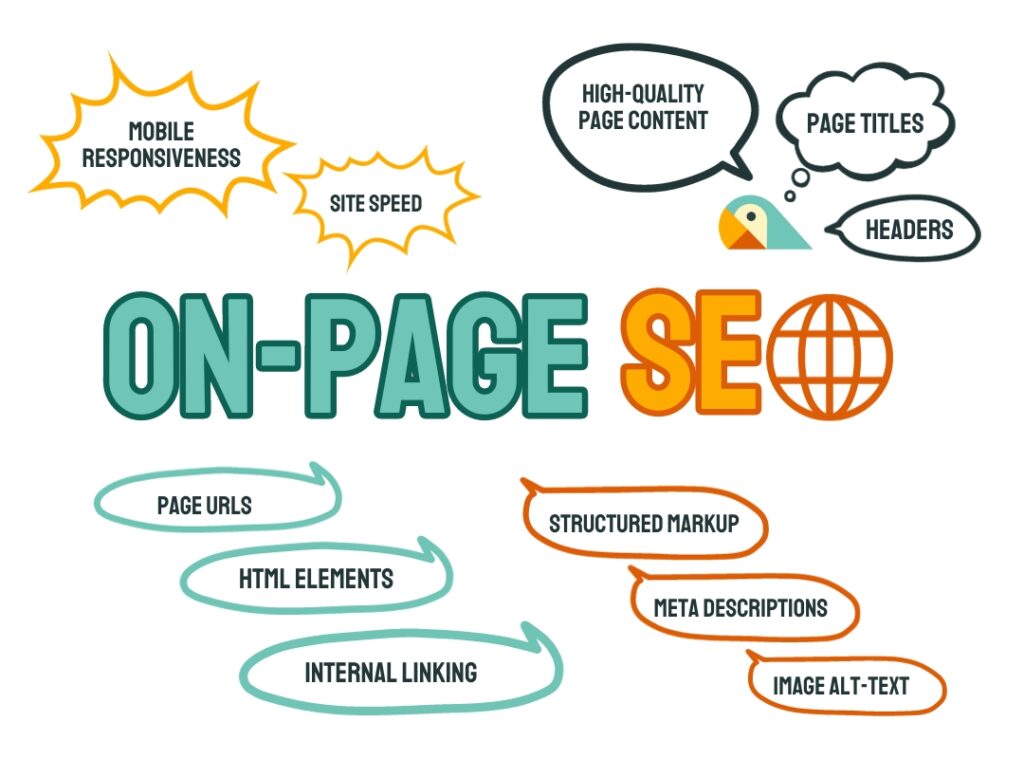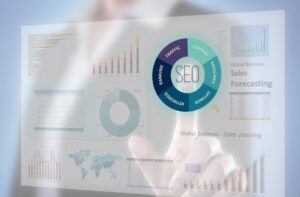At Shantel, our digital marketing team operates on the cutting edge of SEO strategies, continuously refining our approach to on-page SEO.
This facet of SEO is crucial, as it involves optimizing web pages to earn organic traffic and improve a website’s rankings in the search engine results pages (SERPs).
From meticulously crafting meta tags to producing stellar content and beyond, on-page SEO encompasses every element on your web pages.
The Core of On-Page SEO
The crux of on-page SEO lies in making a website more accessible and comprehensible to search engines and users.
When we discuss on-page SEO, we’re talking about both the content and the HTML source code of a page that can be optimized, as opposed to off-page SEO, which refers to links and other external signals.
The Importance of On-Page SEO
On-page SEO is fundamental to the success of any website. It helps search engines analyze your website and its content to determine if a searcher’s query is relevant to your site.
Google has become increasingly sophisticated, but it still requires clues to understand the context of your content. By optimizing these elements, we guide the search engines to interpret the content accurately and rank it accordingly.
Elements of On-Page Optimization
The elements of on-page SEO can be split into content elements, HTML elements, and site architecture elements.
Content elements deal with the quality of the writing and the images you use. HTML elements are the HTML tags that affect search engine rankings, like title tags and meta descriptions.
Site architecture elements are related to the construction of your website and the ease with which search engines can crawl your site.
On-Page SEO Techniques
Our company employs a variety of on-page SEO techniques to enhance our client’s website performance.
These include optimizing title tags, ensuring proper use of heading tags and creating SEO-friendly URLs.
We also focus on writing compelling meta descriptions and improving user engagement through multimedia elements. Each of these techniques is critical in its own right and requires a detailed approach to maximize effectiveness.
Crafting Quality Content
Quality content is the backbone of any effective on-page SEO strategy. The content must not only be original and relevant to the reader’s interests but also structured in a way that search engines can recognize its value.
The Significance of High-Quality Content
The axiom “Content is King” still holds true in the realm of SEO. High-quality content satisfies searchers’ queries effectively, leading to higher dwell times and lower bounce rates—signals that Google uses to rank content. It is also more likely to earn backlinks, which are vital for SEO.
How to Create Outstanding Content
Creating content that stands out requires a deep understanding of your audience’s needs and preferences. We engage in thorough keyword research to discover the terms and phrases our audience uses. We ensure the content is comprehensive and addresses the topic with authority, which often involves long-form content to cover a subject in-depth.
Optimizing Content for Search Engines
Beyond satisfying user intent, the content must be formatted and optimized for search engines. This involves using the right keyword density, including variations and LSI keywords, adding internal and external links with appropriate anchor text, and employing multimedia elements like images and videos with alt text.
HTML Tag Mastery
HTML tags are crucial in on-page SEO, signaling to search engines what your website is about. Optimizing these tags can have a significant impact on your site’s search visibility.
Title Tags and Meta Descriptions
Title tags define the title of a document and are often used on search engine results pages to display preview snippets for a given page. Crafting unique and descriptive titles can heavily influence click-through rates. Meta descriptions, though not a ranking factor, affect user decision-making by providing a concise summary of a page’s content.
Header Tags and Image Alt Text
Header tags are used to structure content for both users and search engines. Proper use of H1 through H6 tags can help organize content clearly, making it easier to read and for search engines to identify key topics on a page. Image alt text is used to describe the appearance and function of an image on a page, which is crucial for both search engines and accessibility.
Fine-Tuning Site Architecture
The way a website is structured can significantly affect its on-page SEO. A well-organized site enables search engines to crawl and index content efficiently while also providing a better user experience.
URL Structure and Navigation
URLs should be clean, well-structured, and include relevant keywords to convey information about the content of the page. Navigation should be intuitive, making it easy for visitors to find the information they need and for search engines to understand the importance and hierarchy of content on your site.
Mobile-Friendliness and Loading Speed
With the mobile-first indexing approach, having a mobile-friendly website is non-negotiable. Sites must perform well across all device types. Page loading speed is also a critical ranking factor, as it affects user experience. We optimize images, minify code, and leverage browser caching to enhance our site speeds.
Use of Schema Markup
Schema markup is a powerful tool for on-page SEO. It helps search engines understand the context of the content, which can lead to rich snippets in SERPs. These rich snippets can improve click-through rates and attract more traffic to your site.
Incorporating Multimedia
Engaging multimedia elements like images, videos, and infographics can improve user experience and retention on a website. However, these elements must be optimized to contribute positively to on-page SEO.
Enhancing User Experience with Multimedia
Multimedia can break up text-heavy content, making it more digestible for the reader. It can also provide different ways to present information, catering to various learning styles. Our company prioritizes the strategic placement of multimedia to keep users engaged and to provide additional value through visual learning.
Multimedia Optimization Techniques
For multimedia to support on-page SEO efforts, it must be optimized correctly. This includes compressing files to decrease loading time, using descriptive file names and alt attributes filled with relevant keywords, and providing transcripts for video and audio content. These steps ensure that multimedia elements are indexed and contribute to the overall SEO of the page.
Advanced On-Page SEO Strategies
Moving beyond the basics, advanced on-page SEO strategies involve a deeper level of optimization to further propel a website’s ranking potential.
Content Refresh and Update
Content can become outdated over time. Updating and refreshing old content ensures it remains relevant and valuable. This not only revitalizes existing content but can also give it a boost in search rankings due to the renewed freshness and updated information.
Topic Clusters and Content Silos
By organizing content into topic clusters and content silos, we create a network of related content that boosts the relevance and authority of each page. This approach involves linking between related pages within a specific category, enhancing the user’s ability to navigate related topics and strengthening the site’s keyword strategy.
User Engagement and Behavioral Factors
Finally, focusing on user engagement metrics like click-through rate, time on page, and bounce rate can provide insights into user satisfaction. High engagement rates signal to search engines that the content is valuable and relevant to the query. At Shantel, we continuously analyze and tweak these elements to maximize our on-page SEO effectiveness.
Final Thoughts
On-page SEO is not a set-and-forget aspect of website optimization. It requires ongoing attention and adaptation to the ever-evolving standards of search engines.
At Shantel, our hands-on experience and dedication to staying abreast of industry changes ensure that our on-page SEO strategies are effective and sustainable.
In an online world where competition is fierce, mastering on-page SEO is crucial for any business aiming to rise above the noise.
Implementing these practices will set the foundation for a robust online presence and drive your website to the top of the search results, where visibility translates directly into success.
FAQs
Can on-page SEO impact my website’s credibility with search engines?
Absolutely. It is a significant indicator of your website’s credibility with search engines. By providing clear, well-structured content, utilizing strategic keywords, and maintaining a seamless user experience, you signal to search engines like Google that your website is a reliable source of information. This can lead to higher rankings and increased visibility.
How often should I revisit my on-page SEO strategy?
On-page SEO is not a one-time task; it requires regular revisits and tweaking. Ideally, you should review it at least once a quarter. However, if there are major updates to search engine algorithms or noticeable shifts in user behavior, it may be prudent to evaluate and adjust your strategy accordingly.
Does the length of my content affect on-page SEO?
Content length itself isn’t a direct ranking factor, but it can influence on-page SEO indirectly. Longer content has more scope to provide comprehensive information, which can improve dwell time and potentially decrease bounce rate. However, the key is relevance and quality – your content should be as long as necessary to fully cover the topic without unnecessary filler.
Are social media signals part of on-page SEO?
Social media signals – such as likes, shares, and comments – are not direct ranking factors for on-page SEO. However, they can amplify your content’s reach, drive traffic to your site, and increase brand visibility, which indirectly may contribute to the page’s value and authority.
How do I know if my on-page SEO efforts are working?
The success can be gauged through various metrics such as organic traffic, search engine rankings for targeted keywords, user engagement metrics (like time on page and bounce rate), and conversion rates. Tools like Google Analytics and Google Search Console can provide valuable insights into these metrics.
Is it better to focus on on-page SEO before off-page SEO?
It’s generally recommended to have a solid on-page SEO foundation before investing heavily in off-page SEO activities like link building. On-page SEO ensures that your site is ready to convert the traffic that off-page efforts drive. Think of it like preparing your store before you start distributing flyers – you want to be sure that once visitors come in, they have a positive experience and find what they’re looking for.






